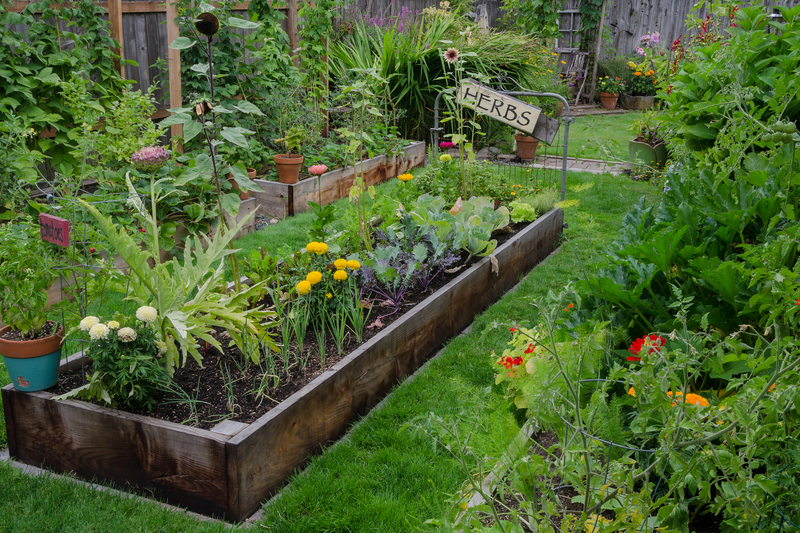Chill-Proofing Your Garden: Essential Winter Care Strategies
Posted on 15/09/2025
Chill-Proofing Your Garden: Essential Winter Care Strategies
Winter is a test for every gardener. When temperatures plummet, frost threatens, and icy winds sweep across your plot, only the smartly prepped gardens thrive while the rest shiver and suffer. So, how can you keep your green spaces vibrant even during the coldest months? This comprehensive guide on chill-proofing your garden walks you through the must-do winter care strategies for protecting your plants and ensuring healthy spring growth.

Why Chill-Proofing Your Garden Matters
If you value your garden, taking winter gardening seriously is essential. Cold conditions can cause lasting harm, from frostbitten shrubs to soil erosion and expensive plant losses. By implementing proven winter garden protection tips and cold weather strategies, you'll set your garden up for lush, healthy growth year-round.
- Prevent frost and freeze damage to delicate plants.
- Reduce stress on perennials and shrubs, ensuring healthier spring recovery.
- Protect garden infrastructure from wind, snow, and ice damage.
- Preserve soil health through moisture and nutrient management.
- Save money by decreasing winter plant losses and replacements.
Assessing Your Garden Before Winter Hits
Chill-proofing your garden starts with preparation and careful assessment. Here's how to get an accurate overview:
1. Identify Cold-Sensitive Plants
- Mark annuals, tropicals, and tender perennials. These are the most vulnerable to frost.
- Note the locations of new plantings and evergreens.
2. Check Soil Quality and Drainage
- Observe how water accumulates after rainfall - poorly drained areas often suffer frost heave and root rot during winter.
- Test soil pH and nutrients. Amendments now can help roots remain strong through winter.
3. Assess Physical Structures
- Check the integrity of raised beds, garden paths, trellises, and fences for any repairs needed before ice and snow accumulate.
- Clean out gutters and drainage channels to prevent winter flooding in garden beds.
The Best Strategies for Chill-Proofing Your Garden
Winter garden care isn't just about saving plants. It's about ensuring the health of the entire garden ecosystem, including soil, beds, and infrastructure. Here are the essential strategies for winterizing your garden with optimal results:
1. Mulching: The Ultimate Insulation
Mulch acts as a blanket, protecting soil and roots from temperature swings and locking in vital moisture. Apply organic mulch 2 to 4 inches thick across your garden, especially around the base of trees and shrubs.
- Use shredded leaves, bark, compost, or straw for best insulation.
- Keep mulch a few inches from tree trunks to prevent rot.
- Mulch even dormant perennial beds - it reduces heaving caused by freeze-thaw cycles.
2. Proper Watering Practices Before the Freeze
Paradoxically, roots need moisture even in the coldest months. Water deeply in autumn before the first hard freeze, especially for new trees, shrubs, or any drought-stressed specimens.
- Moist soil retains heat better than dry soil and protects roots from freezing.
- Water during the day, so plants absorb moisture before overnight cold sets in.
- Stop watering once the ground freezes to avoid ice build-up around roots.
3. Covering and Wrapping Plants
Desperate to save your favorite roses or exotics? Use protective materials such as:
- Horticultural fleece, straw, or burlap for shrubs and roses.
- Cloche covers or old sheets for garden vegetables if frost is predicted.
- Cardboard cones or homemade windbreaks for vulnerable perennials.
Tip: Always remove covers during the day to prevent overheating in sunlight, and re-cover before nightfall when temperatures drop.
4. Pruning for Strength and Health
Winter pruning helps prevent storms from breaking weak, dead, or diseased branches. It also reduces wind damage by allowing heavy snows and winds to pass through the structure more easily.
- Prune deadwood and suckers from trees and shrubs in late autumn.
- Avoid pruning spring-flowering shrubs - wait until after they flower to prevent loss of buds.
- Sanitize your pruning tools between different plants to prevent disease spread.
5. Protecting Containers and Raised Beds
Plants in containers or raised beds are at higher risk from cold weather because their roots are above ground and more exposed.
- Group pots together in sheltered spots, such as against buildings or fences.
- Wrap containers with bubble wrap or hessian for extra insulation.
- Elevate pots off concrete surfaces to prevent them from freezing to the ground.
- Add a thick mulch layer over exposed soil in raised beds.
6. Wind Protection Strategies
Winter winds rapidly dry out foliage and can be more damaging than freezing temperatures alone. Consider:
- Installing windbreaks using fences, hedges, or row covers.
- Positioning evergreen shrubs strategically to shield more delicate plants.
- Staking young or tall plants to prevent wind rock and root disturbance.
Special Focus: Chill-Proofing for Specific Plant Types
Winter Care for Lawns
- Rake up leaves before snowfall -- mats of damp leaves can suffocate grass and invite disease.
- Aerate soil and add fall fertilizer to strengthen grass roots for overwintering.
- Limit walking on your yard when it's frosty to avoid root compaction and damage.
Protecting Herbaceous Perennials
- Mulch well after the first light frost to help insulate roots.
- Do not cut back all perennials: leave some stems/stalks to capture snow, improving insulation and sheltering beneficial insects and pollinators.
- Remove diseased foliage to minimize fungal issues in spring.
Shielding Fruit Trees and Bushes
- Apply a fresh mulch ring but keep it away from trunks to reduce rot.
- Wrap trunks of young trees with tree guards or paper wraps to prevent sunscald and rodent damage.
- Prune dead or crossing branches before winter for better air flow and less snow load.
Veggie Patch: Winterizing Edible Gardens
- Harvest any mature vegetables before hard frosts hit.
- Plant cover crops (like winter rye or clover) to protect and nourish soil.
- Mulch remaining root crops with straw for easy harvesting throughout winter.
Tools, Supplies, and Smart Products for Winter Garden Care
Having the right gear streamlines your chill-proofing efforts. Consider keeping these on hand:
- High-quality fleece covers and cloches
- Heavy-duty mulch (shredded bark, straw, compost)
- Pruning shears and saws, sharpened and sanitized
- Garden twine and stakes for securing covers
- Weather-resistant wraps for containers
- Compost and organic amendments for late autumn soil feeds
- Watering cans with long spouts for targeted hydration
Winter Gardening Myths to Avoid
- "Winter doesn't damage dormant plants." Even plants at rest are vulnerable to desiccation, sunscald, and root freeze.
- "More mulch is always better." Excessive mulching can suffocate roots. Two to four inches is ideal for chill-proofing your garden.
- "You don't need to water in winter." Most winter plant losses result from drought, not cold! Monitor rainfall and supplement only during dry spells before the ground freezes.
- "Prune everything before winter." Some shrubs and trees bloom on old wood and shouldn't be pruned until after flowering.
Encouraging Wildlife to Support Your Winter Garden
Healthy winter gardens aren't just about plants - they include helpful wildlife, too. Birds and beneficial insects can help control pests and maintain garden balance through the cold months.
- Provide clean, unfrozen water sources in heated birdbaths or shallow dishes.
- Install or maintain bird feeders stocked with high-fat seeds.
- Leave seed heads and some perennial stems standing for food and shelter.
- Create brush piles with trimmed branches for cover.

Preparation for Spring: What to Do After Winter
Chill-proofing your garden also means planning for an energetic spring. As winter wanes:
- Remove winter mulch and covers gradually to avoid shocking plants with sudden temperature changes.
- Check for winter-damaged stems, branches, or roots and prune them cleanly.
- Test soil as soon as it's workable, applying needed amendments before planting.
- Rake garden beds gently, cleaning out debris and refreshing edges for planting.
Conclusion: Turn Winter Into a Time of Strength for Your Garden
Don't view winter as a gardening "off-season." Instead, see it as a crucial phase where thoughtful preparation and ongoing care will reward you with resilient, thriving plants and soil when spring arrives. With the smart strategies in this guide to chill-proofing your garden, you can confidently embrace the cold, knowing your garden is protected and primed for another glorious year of growth.
Stay warm, stay wise, and let your garden flourish even through the frostiest days!

